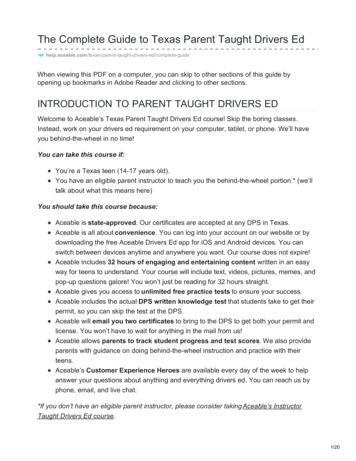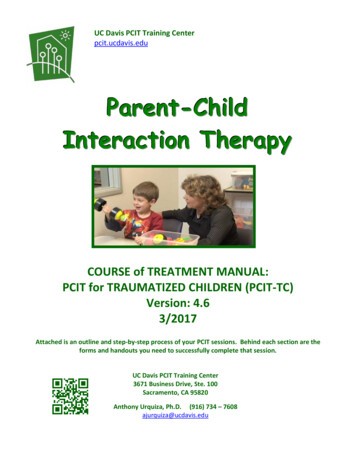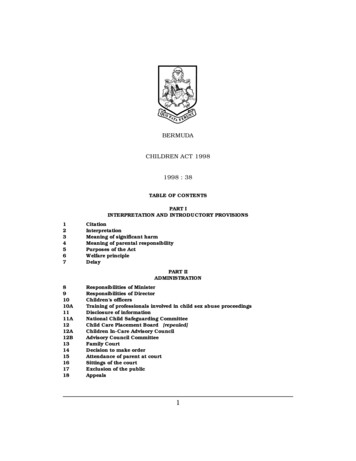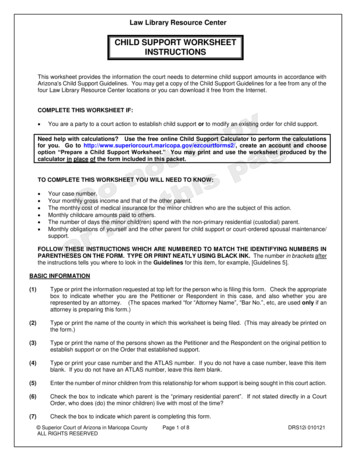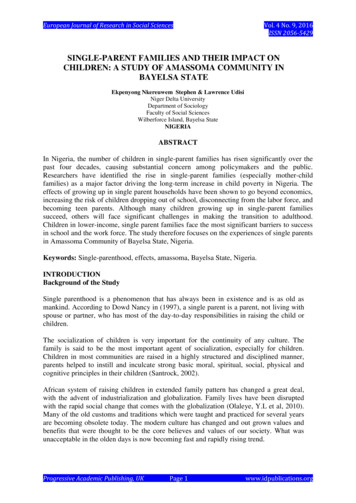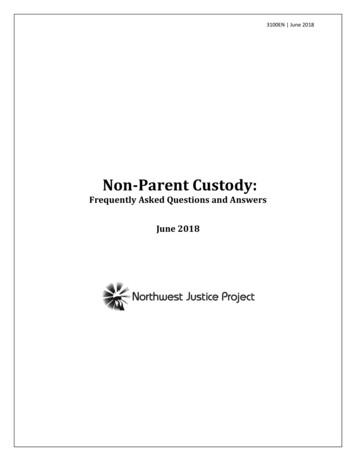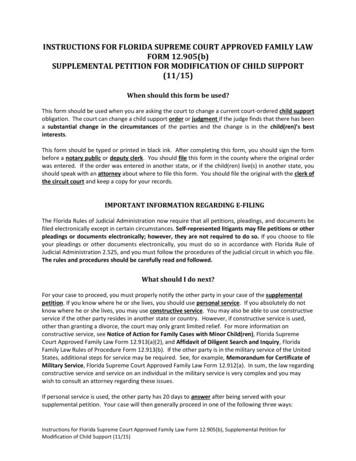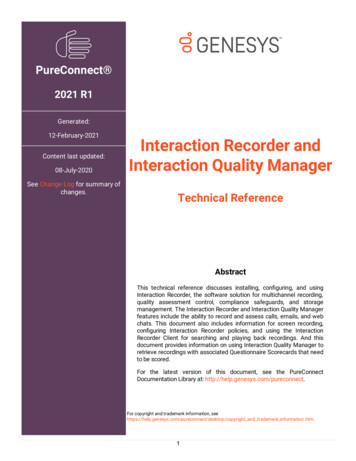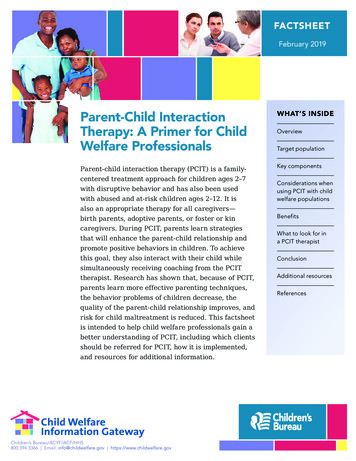
Transcription
FACTSHEETFebruary 2019Parent-Child InteractionTherapy: A Primer for ChildWelfare ProfessionalsOverviewParent-child interaction therapy (PCIT) is a family-Key componentscentered treatment approach for children ages 2–7with disruptive behavior and has also been usedwith abused and at-risk children ages 2–12. It isalso an appropriate therapy for all caregivers—WHAT’S INSIDETarget populationConsiderations whenusing PCIT with childwelfare populationsbirth parents, adoptive parents, or foster or kinBenefitsthat will enhance the parent-child relationship andWhat to look for ina PCIT therapistthis goal, they also interact with their child whileConclusiontherapist. Research has shown that, because of PCIT,Additional resourcesthe behavior problems of children decrease, theReferencescaregivers. During PCIT, parents learn strategiespromote positive behaviors in children. To achievesimultaneously receiving coaching from the PCITparents learn more effective parenting techniques,quality of the parent-child relationship improves, andrisk for child maltreatment is reduced. This factsheetis intended to help child welfare professionals gain abetter understanding of PCIT, including which clientsshould be referred for PCIT, how it is implemented,and resources for additional information.Children’s Bureau/ACYF/ACF/HHS800.394.3366 Email: info@childwelfare.gov https://www.childwelfare.gov
Parent-Child Interaction Therapy: A Primer for Child Welfare ProfessionalsOverviewPCIT is a behavioral parent training approach that wasintroduced in the 1970s to treat young children (generallyages 2–7) with externalizing behavior problems. It hassince been successfully delivered to support familiesof children who have experienced or are at risk ofexperiencing maltreatment (Thomas & Zimmer-Gembeck,2012) as well as children exhibiting internalizing behaviorproblems (Osofsky, Stepka, & King, 2017).1 PCIT addressesnegative parent-child interaction patterns that cancontribute to problem behaviors in young children. Whatsets PCIT apart from other parent training approachesis the treatment of both the parent and child together,coupled with live coaching. (For more information, see theKey Components section of this factsheet.)PCIT addresses many of the complex factors thatcan contribute to negative parenting or parent-childrelationships. Parents who are abusive, or at risk forbeing abusive, often interact in negative ways with theirchildren; use harsh, ineffective, and inconsistent disciplinestrategies; and rely too much on punishment (rather thangiving positive attention to desired behaviors). Childrenin these families may be temporarily compliant due tothe sporadic harsh discipline but also learn to be defiantor noncompliant overall due to inconsistent limit setting,which can create a negative cycle of behaviors by both theparent and child (Kennedy, Kim, Tripodi, Brown, & Gowdy,2016). This cycle of negative behaviors can escalate tothe point of severe physical punishment and physicalabuse. PCIT helps by encouraging positive interactionsbetween parents and children and by training parentshow to implement consistent and nonviolent disciplinetechniques when children act out. Children, in turn,respond to these healthier relationships and interactionswith more positive behaviors.Externalizing behavior problems are those directed outward towardother people or things, such as aggressive actions, disobedience, or beingdisruptive. This is in contrast to internalizing behavior problems, such asanxiety or depression, which are directed inward or “kept inside.”1https://www.childwelfare.govAnother application of PCIT in child welfare is its inclusionin foster parent training. Child behavior problems are arisk factor for foster care placement instability (Fisher,Stoolmiller, Mannering, Takahashi, & Chamberlain, 2011),and PCIT can provide valuable skills foster parents can useto help alleviate these problems.Target PopulationPCIT has been successfully used or adapted for a widerange of child and caregiver populations. Childrentypically are ages 2–7, but the age range can be increasedfor child welfare-involved children when ineffectiveparenting skills, rather than the child’s disruptive behavior,are the referring concern. (See the Considerations WhenUsing PCIT With Child Welfare Populations section ofthis factsheet for more information.) Examples of childpopulations who have benefited from PCIT include thosewith developmental delays, separation anxiety, andhistories of child maltreatment (Wilsie, Campbell, Chaffin,& Funderburk, 2017). Additionally, foster, adoptive, andkinship caregivers are all appropriate recipients of PCIT.PCIT has been successfully used with diverse racial andcultural groups.While PCIT is very effective in addressing certain types ofproblems, there are limitations to its use. For the followingpopulations, PCIT may not be appropriate, or specificmodifications to treatment may be needed: Parents who have limited or no ongoing contact withtheir child Parents with serious mental health problems thatprevent active participation in treatment, such asauditory or visual hallucinations or delusions, or activesubstance use disorders Parents who are hearing impaired and would havetrouble using the earpiece, or parents who havesignificant expressive or receptive language deficits Sexually abusive parents or parents engaging insadistic physical abuseThis material may be freely reproduced and distributed. However, when doing so, please credit Child Welfare Information Gateway.This publication is available online at https://www.childwelfare.gov/pubs/factsheets pcit/.2
Parent-Child Interaction Therapy: A Primer for Child Welfare ProfessionalsKey ComponentsPCIT is typically provided in 10–20 weekly sessions, withan average of 15 sessions. Each session lasts about 1 to1.5 hours. Occasionally, additional treatment sessions areadded as needed. The PCIT curriculum uses a two-phaseapproach: child-directed interaction (CDI), which focuseson relationship enhancement, and parent-directedinteraction (PDI), which focuses on effective disciplinetechniques. Each phase typically begins with one parentonly session for orientation to the approach followedby multiple sessions in which the therapist coaches theparent to master the targeted skills during interactionswith the child.While many other treatment approaches target eitherparents or children, PCIT focuses on changing thebehaviors of both the parent and child together. Parentslearn to model positive behaviors that children canlearn from and are trained to better respond to theirchildren’s behavioral or emotional difficulties. PCIT alsoincorporates live coaching, in which the therapist typicallyobserves the parent-child interactions from behind aone-way mirror while communicating with the parent, whowears a small wireless earpiece. (Although not optimal,clinicians who do not have access to a one-way mirror orearpiece may provide services using in-room coachingor other methods.) The live coaching allows the therapistto provide immediate feedback, including support,guidance, and encouragement, to parents regardingspecific relationship-building and discipline skills learnedduring PCIT sessions.Additionally, the therapist uses a combination ofobservational and standardized assessment measuresto assess parent-child interactions, child behaviors,parental perception of stress related to being a parent,and parents’ perceptions of the difficulty of their child’sbehaviors before, during, and after treatment. Thetherapist conducts a brief assessment at every session todetermine progress and set goals for that session.PCIT can be delivered effectively in either a clinic settingor at home (Fowles et al., 2018). Additionally, providingservices through remote technologies (e.g., the internet)https://www.childwelfare.govhas become more frequent in the mental health field, andat least one study has shown that delivering PCIT usingreal-time video teleconferencing holds promise (Comer etal., 2017).Phase 1: Child-Directed InteractionThis phase emphasizes building a nurturing relationshipand secure bond between the parent and child. DuringCDI sessions, the parent follows the child’s lead in aplay situation while being coached by the therapist.In particular, parents are encouraged to use skillsrepresented in the acronym PRIDE: Praise: Provide specific praise for the child’sappropriate behavior (e.g., saying, “Good job cleaningup your crayons!”) to encourage the behavior andmake the child feel good about his or her relationshipwith the parent Reflection: Repeat and build upon what the child saysto show that the parent is listening and to encourageimproved communication Imitation: Mimic what the child is doing, which showsapproval and helps teach the child how to play withothers Description: Describe the child’s activity (e.g., “You’rebuilding a tower with blocks.”) to demonstrate interestand strengthen mutual play skills Enjoyment: Be engaged and authentic in the playinteractionThe therapist guides parents to use selective attention—giving full attention to desirable behaviors (e.g., sharing)and withholding attention from unwanted or annoyingbehaviors (e.g., rudeness). For example, if a child iscleaning up toys by slamming them into the box whileloudly complaining, the parent could either give attentionto the child’s positive act of cleaning up the toys (e.g.,“Thanks for picking up even though it would be morefun to keep playing.”) or to the bad attitude (e.g., “Whycan’t you be nice with the toys? Stop banging!”). If thebehaviors are destructive or dangerous, however, play isbriefly halted. The therapist also teaches the parents toavoid directive play, questioning the child, and criticismsor negative words.This material may be freely reproduced and distributed. However, when doing so, please credit Child Welfare Information Gateway.This publication is available online at https://www.childwelfare.gov/pubs/factsheets pcit/.3
Parent-Child Interaction Therapy: A Primer for Child Welfare ProfessionalsIn addition to the coached sessions, parents are given5-minute homework assignments each day to practice thenewly acquired skills with their child. Once a parent’s skilllevel meets the program’s identified mastery criteria, thesecond phase of treatment is initiated.Phase II: Parent-Directed InteractionDuring PDI, the therapist teaches the parent to give clear,direct instructions to the child and to provide consistentconsequences for both compliance and noncompliance.When a child obeys the instruction, the parent is told toprovide labeled or specific praise (e.g., “Thank you fordoing what I asked”). When a child disobeys, however, theparent should initiate a timeout procedure. The timeoutprocedure begins with the parent issuing the child awarning and a clear choice of action (e.g., “If you don’tput your toys away, you will have to sit in timeout”). Ifnecessary, the parent may advance to sending the childto a 3-minute timeout in a chair. As with CDI, parents areassigned daily homework to practice the skills outside ofthe sessions.Considerations When Using PCIT WithChild Welfare PopulationsPCIT has been proven to be effective with child welfarepopulations, including with parent-child dyads (pairs)that include an offending parent or a nonoffendingbirth, foster, or adoptive parent (Lieneman, Brabson,Highlander, Wallace, & McNeil, 2017). (See the Benefitssection of this factsheet for additional information aboutoutcomes associated with PCIT.) Because of the uniquecircumstances of child-welfare involved families, however,caseworkers and PCIT therapists may need to take severalfactors into consideration.Therapeutic focus. When the treatment includes acaregiver who was the perpetrator of maltreatment,the focus of the therapy often shifts to parent behaviorchange rather than child behavior change. In thesecases, the child’s behaviors may not necessarily needto fall within the clinical range for a behavioral problemdiagnosis in order to initiate treatment (Wilsie et al., 2017).https://www.childwelfare.govAge. Because the focus of the treatment typically ison the parent rather than the child in cases involving aparent who is a perpetrator, PCIT with these families canbe adapted to include children up to age 12 (rather thanage 7), which does not appear to affect parent outcomes(Wilsie et al., 2017). Age-related adaptations includeadjusting the types of discipline discussed with theparents and increased inclusion of the child in explainingtreatment goals and plans.Skills practice. Parents whose children are in out-ofhome placements may not have access to the childfor daily homework practice, which is an importantcomponent of PCIT. Similarly, if a child remains in out-ofhome care beyond the course of treatment, the parents’newly developed skills may degrade before the childreturns home. In order to include a noncustodial parentin PCIT, the parent should have access to the child atleast three times per week in addition to the PCIT therapysession (Campbell, Chaffin, & Funderburk, 2014).Group sessions. PCIT can be effective for both parentsand children when provided in a group context for variouspopulations, including foster parents (accompanied withphone consultations) (Mersky, Topitzes, Grant-Savela,Brondino, & McNeil, 2016) and families with a risk foror history of maltreatment (Foley, McNeil, Norman, &Wallace, 2016). When adapted for a group, parents frommultiple families may participate in the learning session,participate in role-playing activities with each other,and even observe other parent-child dyads during livecoaching sessions. In addition to the typical positiveoutcomes of PCIT, group sessions may offer a senseof community for the participants and allow parents toobserve other children’s behaviors, which may normalizetheir own children’s behaviors (Foley et al., 2016).Additional services. Child welfare and otherprofessionals should make sure they are notoverwhelming families participating in PCIT with too manyservices or treatments. There is some evidence that PCITmay be more effective when families are not participatingin other simultaneous treatments (Wilsie et al., 2017).This material may be freely reproduced and distributed. However, when doing so, please credit Child Welfare Information Gateway.This publication is available online at https://www.childwelfare.gov/pubs/factsheets pcit/.4
Parent-Child Interaction Therapy: A Primer for Child Welfare Professionalshttps://www.childwelfare.govParent engagement. Given that many familiesinvolved with child welfare may be participating inservices involuntarily, engagement may be a challenge.Additionally, some parents may be ambivalent or hesitantabout services recommended by the child welfare system.Pairing motivational interviewing techniques with PCIT hasbeen shown to reduce child welfare recidivism in familieswith a history of maltreatment (Chaffin, Funderburk, Bard,Valle, & Gurwitch, 2011). Caregivers also may face practicalbarriers to attending treatment, such as transportationor competing demands from the child welfare or othersystems.What to Look for in a PCIT TherapistFor additional information about motivationalinterviewing, refer to Motivational Interviewing: A Primerfor Child Welfare Professionals at erviewing/. How will the parent be involved in this process?BenefitsMultiple randomized clinical studies have found PCIT tobe effective in treating children with behavioral problemsand their families (Osofsky, Stepka, & King, 2017). It wasalso given the highest scientific rating (well-supported)by the California Evidence-Based Clearinghouse for ChildWelfare. PCIT has been shown to decrease behaviorproblems in children, increase children’s compliancewith parental instruction, reduce parental stress, improveparenting behavior and functioning, and improve theparent-child relationship (Wilsie et al., 2017; Thomas &Zimmer-Gembeck, 2007). Additionally, research has shownthat PCIT tends to have lasting benefits (Wilsie et al., 2017).Studies have also shown positive outcomes specificto child welfare populations participating in PCIT. Ithas been found to be effective for physically abusiveparents with children ages 2–12, including reducing ratesof maltreatment recurrence, child behavior problems,parental stress regarding the parent-child relationship,and negative parenting practices (Chaffin et al., 2011;Kennedy et al., 2016; Thomas & Zimmer-Gembeck, 2012).Additionally, group-based PCIT training with fosterparents has been associated with decreases in childbehavior problems (both externalizing and internalizing)(Mersky et al., 2016) as well as improvements in parentingstress and parenting behaviors (Mersky et al., 2015).If PCIT appears to be an appropriate treatment for afamily, you should look for a provider who has receivedadequate training, certification, supervision, andconsultation in PCIT. If feasible, both you and the familyshould have an opportunity to interview potential PCITtherapists prior to beginning treatment. The child andparents should feel comfortable with and have confidencein the therapist with whom they will work.The following are some specific questions to ask atherapist regarding PCIT: What is the nature of your PCIT training? When wereyou trained? By whom? How long was the training?Do you have access to follow-up consultation? Whatresource materials on PCIT are you familiar with? Areyou clinically supervised by (or do you participate ina peer supervision group with) others who are PCITtrained? Why do you feel that PCIT is the appropriate treatmentfor this family? What techniques will you use to help the child managehis or her emotions and related behaviors? What techniques will you use to help the parentdevelop improved skills and understanding? Do you use a standardized assessment process togather baseline information on the functioning ofthe child and family and to monitor their progress intreatment over time? Do you have access to the appropriate equipment forPCIT (one-way mirror, earpiece)? If not, how do youplan to structure the sessions? Is there any potential for harm associated withtreatment?For more information about PCIT training, as well as find alist of certified PCIT therapists, refer to PCIT Internationalat http://www.pcit.org/.This material may be freely reproduced and distributed. However, when doing so, please credit Child Welfare Information Gateway.This publication is available online at https://www.childwelfare.gov/pubs/factsheets pcit/.5
Parent-Child Interaction Therapy: A Primer for Child Welfare ProfessionalsConclusionPCIT is a parent-training strategy with benefits for manyfamilies with child welfare involvement. PCIT’s livecoaching guides parents while they develop neededskills to manage their children’s behavior in a relativelyshort-term treatment (average of 15 hourly sessions). Asparents learn to reinforce positive behaviors, while alsosetting limits and implementing appropriate disciplinetechniques, children’s behavioral problems decrease.Notably, the risk for recurrence of maltreatment in thesefamilies also declines. PCIT is an effective strategyfor helping parents and caregivers build nurturingrelationships that strengthen families and provide healthyenvironments for children to thrive.Additional ResourcesPCIT Internationalhttp://www.pcit.org/California Evidence-Based Clearinghouse for child-interaction-therapy/Parent-Child Interaction Child Therapy .childwelfare.govComer, J. S., Furr, J. M., Miguel, E. M., Carpenter, A. L.,Kerns, C., DeSerisy, M., . . . Chase, R. (2017). Remotelydelivering real-time parent training to the home: Aninitial randomized trial of internet-delivered parentchild interaction therapy (I-PCIT). Journal of Consultingand Clinical Psychology, 85, 909–917. doi: 10.1037/ccp0000230Fisher, P. A., Stoolmiller, M., Mannering, A. M., Takahashi,A., & Chamberlain, P. (2011). Foster placementdisruptions associated with problem behavior:Mitigating a threshold effect. Journal of Consultingand Clinical Psychology, 79, 481–487. doi: 10.1037/a0024313Foley, K., McNeil, C. B., Norman, M., & Wallace, N.M. (2016). Effectiveness of group format parentchild interaction therapy compared to treatmentas usual in a community outreach organization.Child & Family Behavior Therapy, 38, 279–298. doi:10.1080/07317107.2016.1238688Fowles, T. R., Masse, J. J., McGoron, L., Beveridge, R. M.,Williamson, A. A., Smith, M. A., & Parrish, B. P. (2018).Home-based vs. clinic-based parent-child interactiontherapy: Comparative effectiveness in the contextof dissemination and implementation. Journal ofChild and Family Studies, 27, 1115–1129. doi: 10.1007/s10826-017-0958-3ReferencesCampbell, C., Chaffin, M., & Funderburk, B. W. (2014).Parent-child interaction therapy (PCIT) in child welfaresettings. In R. M. Reece, R. F. Hanson, & J. Sargent(Eds.), Treatment of child abuse: Common ground formental health, medical, and legal practitioners (2nded.). Baltimore, MD: Johns Hopkins University Press.Chaffin, M., Funderburk, B., Bard, D., Valle, L. A., &Gurwitch, R. (2011). A combined motivation andparent-child interaction therapy package reduces childwelfare recidivism in a randomized dismantling fieldtrial. Journal of Consulting and Clinical Psychology, 79,84-95. doi: 10.1037/a0021227Kennedy, S. C., Kim, J. S., Tripodi, S., Brown, S. M., &Gowdy, G. (2016). Does parent-child interactiontherapy reduce future physical abuse? A meta-analysis.Research on Social Work Practice, 26, 147–156. doi:10.1177/1049731514543024Lieneman, C. C., Brabson, L. A., Highlander, A., Wallace,N. M., & McNeil, C. B. (2017). Parent-child interactiontherapy: Current perspectives. Psychology Researchand Behavior Management, 10, 239–256. doi: 10.2147/PRBM.S91200This material may be freely reproduced and distributed. However, when doing so, please credit Child Welfare Information Gateway.This publication is available online at https://www.childwelfare.gov/pubs/factsheets pcit/.6
Parent-Child Interaction Therapy: A Primer for Child Welfare ProfessionalsMersky, J. P., Topitzes, J., Grant-Savela, S. D., Brondino,M. J., & McNeil, C. B. (2016). Adapting parent-childinteraction therapy to foster care: Outcomes from arandomized trial. Research on Social Work Practice, 26,157–167. doi: 10.1177/1049731514543023Mersky, J. P., Topitzes, J., Janczewski, C. E., & McNeil, C.B. (2015). Enhancing foster parent training with parentchild interaction therapy: Evidence from a randomizedfield experiment. Journal of the Society for Social Work& Research, 6, 591–616. doi: 10.1086/684123Osofsky, J. D., Stepka, P. T., & King, L. S. (2017). Treatinginfants and young children impacted by trauma:Interventions that promote healthy development.Washington, DC: American Psychological Association.Thomas, R., & Zimmer-Gembeck, M. J. (2007). Behavioraloutcomes of parent-child interaction therapy and TripleP-Positive Parenting Program: A review and metaanalysis. Journal of Abnormal Child Psychology, 35,479–495. doi: 10.1007/s10802-007-9104-9Thomas, R., & Zimmer-Gembeck, M. J. (2012). Parent-childinteraction therapy: An evidence-based treatment forchild maltreatment. Child Maltreatment, 17, 253–266.doi: 10.1177/1077559512459555Wilsie, C., Campbell, C., Chaffin, M., & Funderburk, B.(2017). Parent-child interaction therapy in child welfare.In D. M. Teti (Ed.), Parenting and family processes inchild maltreatment and intervention (107–125). Cham,Switzerland: Springer International Publishing.Suggested Citation:Child Welfare Information Gateway. (2019). Parentchild interaction therapy: A primer for child welfareprofessionals. Washington, DC: U.S. Department of Healthand Human Services, Children’s Bureau.U.S. Department of Health and Human ServicesAdministration for Children and FamiliesAdministration on Children, Youth and FamiliesChildren’s Bureauhttps://www.childwelfare.gov
experiencing maltreatment (Thomas & Zimmer-Gembeck, 2012) as well as children exhibiting internalizing behavior problems (Osofsky, Stepka, & King, 2017). 1 PCIT addresses negative parent-child interaction patterns that can contribute to problem behaviors in young children. What sets PCIT apart from other parent training approaches
